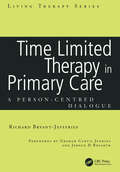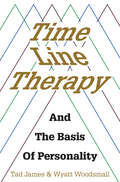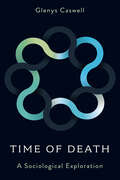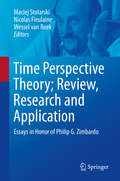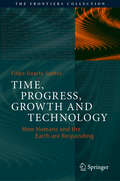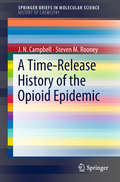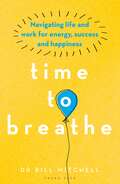- Table View
- List View
Time-Limited Psychotherapy in Practice
by Gaby SheflerTherapists and counsellors are under increasing pressure to provide effective treatment in a time-limited, demonstrably effective form. Time-Limited Psychotherapy (TLP) has developed in response, and is designed to give clients an intense form of therapy over 12 sessions. This title: * Uses vivid clinical descriptions of treatments and up-to-date research findings * Describes what the treatments entail * Discusses their outcome * Deals with teaching and learning of TLP regarding the changing conditions in public needs and in public services. Time-Limited Psychotherapy in Practice will appeal to psychotherapists, counsellors, researchers and academics in the mental health field.
Time-Limited Psychotherapy in Practice
by Gaby SheflerTherapists and counsellors are under increasing pressure to provide effective treatment in a time-limited, demonstrably effective form. Time-Limited Psychotherapy (TLP) has developed in response, and is designed to give clients an intense form of therapy over 12 sessions. This title: * Uses vivid clinical descriptions of treatments and up-to-date research findings * Describes what the treatments entail * Discusses their outcome * Deals with teaching and learning of TLP regarding the changing conditions in public needs and in public services. Time-Limited Psychotherapy in Practice will appeal to psychotherapists, counsellors, researchers and academics in the mental health field.
Time-Limited Therapy in a General Practice Setting: How to Help within Six Sessions (PDF)
by Dr Glyn Hudson-Allez`[An] excellent book... an important source of learning, bringing clarity and insight into often isolated areas' - Counselling in Medical Settings (CMS) Journal `Glyn Hudson-Allez's book is very well researched and clearly written... time-limited therapy is an effective and professional means of offering practical help and the book is highly recommended reading for all counsellors wishing to work in this way' - Family Practice As general practitioners are increasingly capping provision of counselling sessions, time-limited therapy skills are becoming ever-more important to counsellors working alongside GPs. Time-limited therapy provides a specific set of skills which enable counsellors to cope successfully with the large number and wide range of referrals they can receive in primary care settings. This book covers both difficulties commonly presented in primary care, such as anxiety, stress, bereavement and depression, and problems not usually considered appropriate for working within a time-limited framework - such as eating disorders, medical complaints and abuse: the author shows that clients with such problems can also be helped effectively. Integrating counselling skills with psychological knowledge, Glyn Hudson-Allez outlines the psychological and physical aspects of each problem and provides concise guidelines, with illustrative case studies, on how time-limited therapy can be used efficiently in each case. She also discusses the administration and evaluation of a counselling service within primary care.
Time Limited Therapy in Primary Care: A Person-Centred Dialogue (Living Therapies Series)
by Richard Bryant-Jefferies"Many counsellors who work in primary care find it difficult to explain to colleagues in the primary care team what they actually do with clients behind the closed door of their room. In this book the author brings to life in a gripping way what really does go on when a counsellor sees a patient in the primary healthcare setting. It’s good to read for once a book that describes so realistically and movingly the minute-by-minute account of what actually happens, not a book describing clever therapists getting it right all the time. The book should be required reading for newly appointed non-clinical managers of counselling services and for primary healthcare staff about to start working with a counsellor as a member of their team."— Graham Curtis Jenkins in his Foreword
Time Limited Therapy in Primary Care: A Person-Centred Dialogue (Living Therapies Series)
by Richard Bryant-Jefferies"Many counsellors who work in primary care find it difficult to explain to colleagues in the primary care team what they actually do with clients behind the closed door of their room. In this book the author brings to life in a gripping way what really does go on when a counsellor sees a patient in the primary healthcare setting. It’s good to read for once a book that describes so realistically and movingly the minute-by-minute account of what actually happens, not a book describing clever therapists getting it right all the time. The book should be required reading for newly appointed non-clinical managers of counselling services and for primary healthcare staff about to start working with a counsellor as a member of their team."— Graham Curtis Jenkins in his Foreword
Time Line Therapy: and the basis of personality
by Tad James Wyatt WoodsmallWritten by Tad James and Wyatt Woodsmall, Time Line Therapy and the Basis of Personality is a compelling study of the important elements that make up a person’s core personality, and a detailed exploration of – and introduction to – how Time Line therapy works in practice. Utilizing discoveries made by Richard Bandler, Time Line Therapy and the Basis of Personality expands and updates our knowledge of how people actually store their memories, and sheds light on the effect that the system used for memory storage has on the individual. The authors contend that the concept of Time Line, or the notion of time that you have stored in your mind, shapes and structures your experience of the world, and consequently shapes your personality. Time Line therapy is therefore based on the premise that the client goes back to the first time they remember a particular problem, does change work – utilizing Neuro Linguistic Programming (NLP) to eliminate irritating behaviors or issues – and, if necessary, goes to subsequent times when their behavior or response was a problem, and undertakes further change work to resolve it. Written in an informative and engaging manner, Time Line Therapy and the Basis of Personality offers readers the opportunity to see how Time Line therapy works – providing a clear description of how to elicit the Time Line, and sharing step-by-step methods to subsequently help the client to release a limiting decision or trauma, remove anxiety, or set a future goal. All of these key aspects are explained using clear language and easy-to-follow steps, and the authors’ expert commentary is further complemented by examples, exercises and transcripts in order to help the reader transfer the theory into effective practice. In Section I, the authors explain the NLP Communication Model and share their in-depth analysis of the filters – values, beliefs, attitudes, decisions, memories and meta programs – which we subconsciously use as we process the world around us and which form the basis of our personalities. Section II provides a comprehensive description of the Time Line and how it works: laying down a theoretical basis for the technique before offering insight into its practice and application with a demonstrative transcript of Time Line elicitation and change work in order to illustrate the concepts explored. In Section III the authors move on to carefully survey simple and complex meta programs (and how they can be changed) before exploring the formation, evolution and changing of values in Section IV, which includes a helpful exercise that gives guidance on how to elicit values from the client. Exploring many interesting contexts and how personality can be positively changed to help people live happier lives, Time Line Therapy and the Basis of Personality is a worthy addition to any therapist’s or NLP practitioner’s library and is suitable reading for anyone interested in behavioral change. Sections include: Section I – Introduction; Section II – Time Line Therapy; Section III – Meta Programs; Section IV – Values. Time Line Therapy and the Basis of Personality was originally published in 1988 by Meta Publications.
Time Lived, Without Its Flow
by Denise Riley'I work to earth my heart.'Time Lived, Without Its Flow is an astonishing, unflinching essay on the nature of grief from critically acclaimed poet Denise Riley. From the horrific experience of maternal grief Riley wrote her lauded collection Say Something Back, a modern classic of British poetry. This essay is a companion piece to that work, looking at the way time stops when we lose someone suddenly from our lives. The first half is formed of diary-like entries written by Riley after the news of her son’s death, the entries building to paint a live portrait of loss. The second half is a ruminative post script written some years later with Riley looking back at the experience philosophically and attempting to map through it a literature of consolation. Written in precise and exacting prose, with remarkable insight and grace this book will form kind counsel to all those living on in the wake of grief. A modern-day counterpart to C. S. Lewis’s A Grief Observed.Published widely for the first time, this revised edition features a special introduction by Max Porter, author of Grief is A Thing With Feathers.'Her writing is perfectly weighted, justifies its existence' - Guardian
Time of Death: A Sociological Exploration
by Glenys CaswellAddressing a gap in social science research to explore the meanings, understandings, and experiences of time at life’s most critical point, Time of Death takes a thoughtful sociological approach to questions about how humans use and experience time in relation to when someone dies. Considering temporal theories and drawing on a range of disciplines, Glenys Caswell discusses efforts to measure and record times of death, as well as the ways in which people who undergo bereavement experience time during that process. Looking at the impact of digital technologies, the differences in interpretation of what counts as death in varied social contexts, assisted dying and temporal dissonance, and global cases of people dying alone, the author poses critical questions. To what extent is this measurement the province of the medical and legal professions, and official state statistics? How accurate is this data and is there need for its collection? How does time in relation to death become fluid in a previously non-experienced way? Investigating this conceptual focus and questioning what it can add to our knowledge of the human relationship with time, Caswell brings together studies on death and temporality to create a valuable resource for scholars across disciplines.
Time of Death: A Sociological Exploration
by Glenys CaswellAddressing a gap in social science research to explore the meanings, understandings, and experiences of time at life’s most critical point, Time of Death takes a thoughtful sociological approach to questions about how humans use and experience time in relation to when someone dies. Considering temporal theories and drawing on a range of disciplines, Glenys Caswell discusses efforts to measure and record times of death, as well as the ways in which people who undergo bereavement experience time during that process. Looking at the impact of digital technologies, the differences in interpretation of what counts as death in varied social contexts, assisted dying and temporal dissonance, and global cases of people dying alone, the author poses critical questions. To what extent is this measurement the province of the medical and legal professions, and official state statistics? How accurate is this data and is there need for its collection? How does time in relation to death become fluid in a previously non-experienced way? Investigating this conceptual focus and questioning what it can add to our knowledge of the human relationship with time, Caswell brings together studies on death and temporality to create a valuable resource for scholars across disciplines.
The Time of Our Lives: an emotional and hilarious story of friendship
by Abby Williams'The Time of Our Lives is a life-affirming story full of humour and warmth, centred around a friendship that is both ageless and timeless. I absolutely loved it. It has made me want to find a senior citizen BFF of my own!' Dani Atkins, bestselling author of Fractured. 'Beautifully written, The Time of Our Lives in an uplifting, feel-good read about loss and friendship and making the absolute best of an unexpected situation. Lydia and Erin are instantly relatable and I was rooting from them from beginning to end. A lovely, well-crafted story that left me smiling and wishing I could stay in Lydia and Erin's world for a little longer' Ella Harper, author of If I Fall. Two women from two very different generations are brought together through dramatic circumstances and help each other to forge new paths. Twenty-six-year-old Erin has everything she's ever wanted – a good job, a gorgeous fiancé and a best friend who's always there for her. But suddenly her life comes crashing down around her. Unable to return home to her parents, she takes a room in a house nearby and her life starts over in the most unexpected of ways... Seventy-six-year-old Lydia, who, shocked by the sudden death of her husband, is devastated to discover that he has left her in crippling debt. With no choice but to take in a lodger, Erin comes into her life. When they find a letter hidden in the attic old secrets come to light and, with Erin by her side, Lydia finds herself going on a trip of a lifetime. Perfect for fans of The Flatshare, 59 Memory Lane and If Only I Could Tell You.
The Time of the Crime: Phenomenology, Psychoanalysis, Italian Film
by Domietta TorlascoThe Time of the Crime interrogates the relationship between time and vision as it emerges in five Italian films from the sixties and seventies: Antonioni's Blow-Up and The Passenger, Bertolucci's The Spider's Stratagem, Cavani's The Night Porter, and Pasolini's Oedipus Rex. The center around which these films revolve is the image of the crime scene—the spatial and temporal configuration in which a crime is committed, witnessed, and investigated. By pushing the detective story to its extreme limits, they articulate forms of time that defy any clear-cut distinction between past, present, and future—presenting an uncertain temporality that can be made visible but not calculated, and challenging notions of visual mastery and social control. If the detective story proper begins with a death that has already taken place, the death that seems to count the most in these films is the one that is yet to occur—the investigator's own death. In a time of relentless anticipation, what appears in front of the investigator's eyes is not the past as it was, but the past as it will have been in relation to the time of his or her search.
The Time of the Therapeutic Communities: People, Places and Events (PDF)
by Liam ClarkeFrom the 1950s onwards different movements, ideas and key figures have contributed to the initiative which is now recognized as Therapeutic Communities (TCs). This book follows these post-war changes (such as "libertarianism" and the "open door movement") through to the present day and discusses the influence they had on the practice of psychiatry and the introduction of TCs. Including chapters on the work and influence of Joshua Bierer and R.D. Laing, and providing an explanation of the Villa 21 project (the only attempt to apply Laingian concepts in an NHS setting), Clarke also examines TC viewpoints on current debates, such as the forcible treatment of mentally ill people perceived to be a threat to society, the gradual emergence of the hospitalization versus community question, and the problem of custody within psychiatric care. Providing a thorough analysis of the emergence and progression of TCs, this book is essential reading for anyone involved in the field.
Time Perspective: Theory and Practice
by Derek Chadee Aleksandra KostićThis book focusses on the theory and application of ‘time perspective theory’. Time perspective can be an important factor in determining psychological well-being and the way we see our world and others around us. The unique contemporary nature of this theory’s evolution has spurred great interest over the last 20 years. The editors responded to this interest by bringing together contributors across a multitude of subjects and perspectives to facilitate an unprecedented discussion on the topic; covering areas such as financial health, psychotherapy across adulthood and old age, prenatal past, metacognition, community and change, fear of crime and intrinsic motivations. The interdisciplinary nature of this project makes it of interest to a wide cross-section of academics and practitioners including psychologist, social workers, criminologists and anyone who has or wishes to adopted time perspective theorization to assist them in their understanding.
Time Perspective Theory; Review, Research and Application: Essays in Honor of Philip G. Zimbardo
by Maciej Stolarski Nicolas Fieulaine Wessel Van BeekThis book is about time and its powerful influence on our personal and collective daily life. It presents the most comprehensive and up-to-date overview of contemporary knowledge on temporal psychology inspired by Zimbardo's work on Time Perspective (TP). With contributions from renowned and promising researchers from all over the globe, and at the interface of social, personality, cognitive and clinical psychology, the handbook captures the breadth and depth of the field of psychological time. Time perspective, as the way people construe the past, the present and the future, is conceived and presented not only as one of the most influential dimensions in our psychological life leading to self-impairing behaviors, but also as a facet of our person that can be de-biased and supportive for well-being and happiness. Written in honor of Philip G. Zimbardo on his 80th birthday and in acknowledgement of his leading role in the field, the book contains illustrations of the countless studies and applications that his theory has stimulated, and captures the theoretical, methodological and practical pathways he opened by his prolific research.
Time Present and Time Past: Selected Papers of Pearl King
by Pearl KingThis remarkable collection of papers is divided into three sections: clinical issues; psychoanalysis and the life cycle; and underlying theories of practice. The papers span the years 1951 to 2004, recording five decades of British psychoanalysis, through various angles. The papers in the clinical part include a unique, lengthy case study of the psychoanalysis of a four-year-old boy, and a follow-up of his life over five decades later. After reading the paper at the age of 54, the patient agreed to write his own version of his life, which is included in the book. The second part of the book, on psychoanalysis and the life cycle, includes renowned chapters on ageing. The author looks at the ageing psychoanalyst as well as the characteristics of analysis with older patients. The third part discusses the theories underlying the author's practice and puts forward her views on such concepts as alienation, transference, and the importance of time in psychoanalytic work with patients.
Time Present and Time Past: Selected Papers of Pearl King
by Pearl KingThis remarkable collection of papers is divided into three sections: clinical issues; psychoanalysis and the life cycle; and underlying theories of practice. The papers span the years 1951 to 2004, recording five decades of British psychoanalysis, through various angles. The papers in the clinical part include a unique, lengthy case study of the psychoanalysis of a four-year-old boy, and a follow-up of his life over five decades later. After reading the paper at the age of 54, the patient agreed to write his own version of his life, which is included in the book. The second part of the book, on psychoanalysis and the life cycle, includes renowned chapters on ageing. The author looks at the ageing psychoanalyst as well as the characteristics of analysis with older patients. The third part discusses the theories underlying the author's practice and puts forward her views on such concepts as alienation, transference, and the importance of time in psychoanalytic work with patients.
Time Pressure and Stress in Human Judgment and Decision Making
by A. JohnMaule OlaSvensonSome years ago we, the editors of this volume, found out about each other's deeply rooted interest in the concept of time, the usage of time, and the effects of shortage of time on human thought and behavior. Since then we have fostered the idea of bringing together different perspectives in this area. We are now, there fore, very content that our idea has materialized in the present volume. There is both anecdotal and empirical evidence to suggest that time con straints may affect behavior. Managers and other professional decision makers frequently identify time pressure as a major constraint on their behavior (Isen berg, 1984). Chamberlain and Zika (1990) provide empirical support for this view, showing that complaints of insufficient time are the most frequently report ed everyday minor stressors or hassles for all groups of people except the elderly. Similarly, studies in occupational settings have identified time pressure as one of the central components of workload (Derrich, 1988; O'Donnel & Eggemeier, 1986).
Time, Progress, Growth and Technology: How Humans and the Earth are Responding (The Frontiers Collection)
by Filipe Duarte SantosThis book addresses the current challenges of sustainable development, including its social, economic and environmental components. The author argues that we need to develop a new concept of time based on inter-generational solidarity, which focuses both on the long- and the short term. The evolution of man's notions of time are analyzed from prehistory to modern times, showing how these concepts shape our worldviews, our ecological paradigms and our equilibrium with our planet. Practical approaches to dealing with the major medium- and long term sustainability challenges of the 21st century are presented and discussed. This is a thought provoking and timely book that addresses the main global socioeconomic and environmental challenges facing the current and future generations, using science-based analysis and perspectives. It presents an historical narrative of the advent of progress, economic growth and technology, and discusses the structural changes needed to co-create sustainable pathways. It provides hope for our future on Earth, mankind’s common home. António Guterres, Secretary-General of the United Nations This is an amazing, almost mind-boggling book. The author takes a look at the true whole, i.e., the development of the human enterprise since its very beginning. This enterprise is evidently a possibility under the boundary conditions of cosmological dynamics and natural evolution, but evidently also a highly improbable one. It is all but a miracle that the Earth system in its present form exists and happens to support a technical civilization. Will this civilization last long, will it transform itself into something even more exceptional, or will it perish in disgrace?Santos dares to address these grandest of all questions, equipped with a unique transdisciplinary wisdom drawing on physics, cybernetics, geology, biology, economics, anthropology, history, and philosophy. And he dares to dive into the deepest abysses of thinking, where categorial monsters like time and progress lurk. Thereby, he takes us on fascinating journey, during which we perceive and grasp things we have never seen and understood before. One of the best essays I have ever read. John Schellnhuber, founding director of the Potsdam Institute for Climate Impact Research (PIK) and former chair of the German Advisory Council on Global Change
A Time-Release History of the Opioid Epidemic (SpringerBriefs in Molecular Science)
by J. N. Campbell Steven M. RooneyThis Brief takes the reader on a chemical journey by following the history for over two centuries of how an opiate became an opioid, thus spawning an empire and a series of crises. These imperfect resemblances of alkaloids are both natural and synthetic substances that, particularly in America, are continually part of a growing concern about overuse. This seemed an inviting prospect for those in pain, but as the ubiquitous media coverage continues to lay bare, the levels of abuse point to the fact that perhaps an epidemic is upon us, if not a culture war. Seeking answers to how and why this addiction crisis transpired over two hundred years of long development, this Brief examines the role that the chemistry laboratory played in turning patients into consumers. By utilizing a host of diverse sources, this Brief seeks to trace the design and the production of opioids and their antecedents over the past two centuries. From the isolation and development of the first alkaloids with morphine that relieved pain within the home and on the battlefield, to the widespread use of nostrums and the addiction crisis that ensued, to the dissemination of drugs by what became known as Big Pharma after the World Wars; and finally, to competition from home-made pharmaceuticals, the progenitor was always, in some form, a type of chemistry lab. At times, the laboratory pressed science to think deeply about society's maladies, such as curing disease and alleviating pain, in order to look for new opportunities in the name of progress. Despite the best intentions opioids have created a paradox of pain as they were manipulated by creating relief with synthetic precision and influencing a dystopian vision. Thus, influence came in many forms, from governments, from the medical community, and from the entrepreneurial aspirations of the general populace. For better, but mostly for worse, all played a role in changing forever the trajectory of what started with the isolation of a compound in Germany. Combining chemistry and history in a rousing new long-form narrative that even broadens the definition of a laboratory, the origins and future of this complicated topic are carefully examined.
Time Series in Psychology
by R. A.M. GregsonFirst published in 1983. Routledge is an imprint of Taylor & Francis, an informa company.
Time Series in Psychology
by R. A.M. GregsonFirst published in 1983. Routledge is an imprint of Taylor & Francis, an informa company.
Time, Space and Phantasy (The New Library of Psychoanalysis)
by Rosine Jozef PerelbergTime, Space, and Phantasy examines the connections between time, space, phantasy and sexuality in clinical practice. It explores the subtleties of the encounter between patient and analyst, addressing how aspects of the patient’s unconscious past are actualised in the present, producing new meanings that can be re-translated to the past. Perelberg’s analysis of Freud’s Multi-dimensional model of temporality suggests that he always viewed the constitution of the individual as non-linear. In Freud’s formulations, the individual is decentred and ruled by different temporalities, most of which escape their consciousness. Perelberg identifies the similarities between this and Einstein’s theory of relativity which states that rather than being absolute, time depends on the relative position and speed of the observing individual suggesting that rather than being a reality, time is an abstraction, connecting objects and events. Throughout this text, Perelberg draws together connections between time, mental space, and phantasy showing how time is constantly reshaped in the light of new events and experiences. This book will be of interest to psychoanalysts, psychotherapists, psychologists, and social workers.
Time, Space and Phantasy (The New Library of Psychoanalysis)
by Rosine Jozef PerelbergTime, Space, and Phantasy examines the connections between time, space, phantasy and sexuality in clinical practice. It explores the subtleties of the encounter between patient and analyst, addressing how aspects of the patient’s unconscious past are actualised in the present, producing new meanings that can be re-translated to the past. Perelberg’s analysis of Freud’s Multi-dimensional model of temporality suggests that he always viewed the constitution of the individual as non-linear. In Freud’s formulations, the individual is decentred and ruled by different temporalities, most of which escape their consciousness. Perelberg identifies the similarities between this and Einstein’s theory of relativity which states that rather than being absolute, time depends on the relative position and speed of the observing individual suggesting that rather than being a reality, time is an abstraction, connecting objects and events. Throughout this text, Perelberg draws together connections between time, mental space, and phantasy showing how time is constantly reshaped in the light of new events and experiences. This book will be of interest to psychoanalysts, psychotherapists, psychologists, and social workers.
Time to Breathe: Navigating Life and Work for Energy, Success and Happiness
by Dr Bill MitchellThis book is for people who are struggling with the multiple demands of jobs that never seem to end and the complexities of their home lives. Struggling on without thinking through how to make it work can lead to exhaustion, unhappiness, burn-out or depression.Time To Breathe presents practical ideas that come out of Dr Bill Mitchell's clinical experience in getting people back to a zone of better energy, balance, fulfilment and more balanced ways of thinking about themselves. Through case studies of the everyday lives of people in many walks of professional life, we see how many of us can accidentally set off down a pathway that takes us away from our previously healthy robust selves - often without recognising it. When we can no longer stabilise our emotions and protect our energy we become overwhelmed, and rather than confident become self-doubting, guilty and anxious. This book describes three key building blocks of a balancing system to keep us within the energised healthy zone, in spite of the pressures we are under at work and at home. These are: self-awareness, an understanding of the physiology of energy, and a willingness to lead a more decisions-based life for better balance and effective working. Together, these form an overarching empowered mindset, freeing us from the mental habits that lead us to de-prioritise time for ourselves. And leading to far happier outcomes than feeling trapped and helpless, or walking away from career paths into which we have invested years of our lives.
Time to Breathe: Navigating Life and Work for Energy, Success and Happiness
by Dr Bill MitchellEver feel like you're so busy and stressed that you forget to breathe?Dr. Bill Mitchell is here to help. A psychologist who specialises in rebalancing the lives of the overwhelmed, overstressed and overscheduled, in this book Bill brings you tried and tested, practical solutions that will help you protect your energy and prioritise what is most important.Find out how to prevent the drift towards burnout and poor mental health that so many of us suffer from in our busy modern lives. Your family – and your boss – will thank you.


